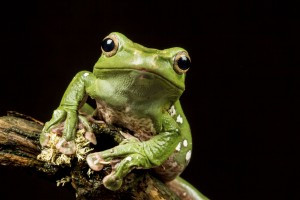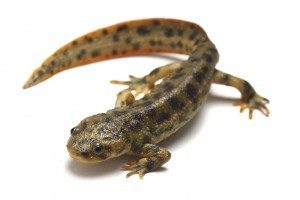Don’t Overlook Amphibians
Tom Mazorlig //September 1, 2015//
 Amphibians—frog, toads, newts, salamanders and caecilians—are usually lumped in with the more numerous and popular reptiles but they are different animals with their own special needs.
Amphibians—frog, toads, newts, salamanders and caecilians—are usually lumped in with the more numerous and popular reptiles but they are different animals with their own special needs.
Humidify Me
One of the differences between most reptiles and most amphibians is the latter’s need for higher levels of humidity. Most of the amphibians in the pet trade are intolerant of dry conditions. This can make them a bit more challenging for both the retailer and the keeper.
This need for higher humidity can be turned into an opportunity to sell products to address the issue. The right substrate can go a long way toward providing amphibians with proper humidity levels.
“The perfect substrate for amphibians would have to be our Tropicoco Coconut Soil,” said Apollo Owens, sales at Galapagos Reptile Gear. “Not only is it a byproduct of the coconut industry which helps preserve natural resources, coconut husk also helps deter harmful bacteria and molds in the enclosure.”
“Eco Earth is one of our most popular products and an ideal substrate for most terrestrial and arboreal amphibians,” said Ashley Rademacher, animal care and education coordinator at Zoo Med Labs, Inc. “This ground coconut husk substrate is great for maintaining humidity and creating moist, tropical habitats. It can be used for live plants and is available in loose bags or compressed bricks.”
Various mosses also make excellent substrates for many amphibians. They can be used alone, as a top layer over another substrate or as a decorative element. Owners can also place moss in a hide box to create a humidified shelter.
“Galapagos’ Royal Pillow Moss can triple its weight with water retention,” said Owens. “It is also one of the rarest mosses in the pet industry and is not carried by anyone else that I know of.”
Galapagos also offers New Zealand Sphagnum Moss and Sheet Moss for the keepers of humidity loving amphibians.
There’s also Zilla Beaked Moss and Zilla Compressed Frog Moss from Central Garden & Pet that make great amphibian substrates.
Besides substrates, there are other products that can help address the humidity needs of amphibians. Misters and foggers will certainly do the job.
While some hobbyists are happy to use handheld misters, many get tired of having to use their hand power to pump mist into the enclosure. This is especially tedious for keepers with multiple enclosures.
Zoo Med’s Repti Rain is an automated misting machine that’s programmable to spray for different durations and a different number of times per day depending on the needs of the pet. It can mist two different enclosures.
Exo Terra’s Fogger is an ultrasonic fog generator that easily humidifies the terrarium. The fog also creates a misty visual effect.
Species to Stock
There’s also the question of which amphibians a pet store should stock.
“There are a number of frogs that are great options for retailers,” said Michael Griffith, marketing specialist for Segrest Farms. “One of my favorites are White’s tree frogs. They are less demanding and easier to care for than dart frogs and will be happy in a tall enclosure with a few live or fake plants and maybe some vines or branches to climb and rest on. They are also extremely hardy and robust enough that if the keeper really wanted to occasionally handle it they could.”
“Another good frog choice would be red-eyed tree frogs,” said Griffith. “You can readily get captive-bred individuals that are quite hardy and their charismatic appearance is great for attracting customers’ attention.”
Don’t overlook some of the aquatic amphibians typically sold in the fish section.
“Aquatic frogs are extremely popular and are fairly easy to set up aquariums for,” said Griffith. “African dwarf frogs stay quite small, don’t require large aquariums and with care can be kept with certain community fish. They are by far the most popular amphibian we offer.”
“Another great option are Iberian ribbed newts. They are almost fully aquatic and can survive almost anything,” said Griffith.
Zoo Med has several products for these water-dwelling species.
“Our new 10 and 20 gallon Designer Terrariums, Nano Filters and Floating Aquarium Logs can help create an ideal habitat for aquatic amphibians,” said Rademacher. “Our Aquatic Newt and Aquatic Frog and Tadpole foods have been designed specifically to meet the nutritional needs of these animals,” said Rademacher
Making Sales Hop
To sell these animals and the supplies for them, retailers may want to consider thinking of them more like fish.
“The challenge for amphibians is that most consumers want pets that can be handled, and very few amphibians can be,” said Griffith. “In order to be successful with amphibians, retailers need to approach them differently than reptiles and more like fish. They should treat amphibians as display only animals and try to create interest in beautiful setups where the amphibian may not be the central focus. In these setups, the frogs end up being that extra bit of icing on the cake that take an appealing tank to being exciting.”
This approach requires stocking the right products and having an educated staff.
“For retailers, to generate interest and capitalize on this, you need to have beautiful, quality setups in your store, all the supplies necessary for a customer to put it together on their own and a knowledgeable staff that can not only help customers with the initial setup but also guide them through the subsequent maintenance to keep the terrarium thriving.” Griffith
Setups containing products sold in the store generate sales.
“I always recommend using the products in the store with the animals being sold. This gives customers an opportunity to see the products in use and allows the animals to acclimate to them,” said Rademacher. “Additionally, when employees have hands-on experience with the products, it is easier to recommend these items to a customer no matter where they acquired their animals.”
Retailers may want to consider the value of letting customers touch products.
“I’d recommend having samples of substrates, mosses and decor items outside of the tanks and packaging,” said Owens. “People love to touch and feel products before actually purchasing. I’ve found that the first thing people do is physically grab, squeeze, and smell our products. A small display of products is sufficient enough for



















